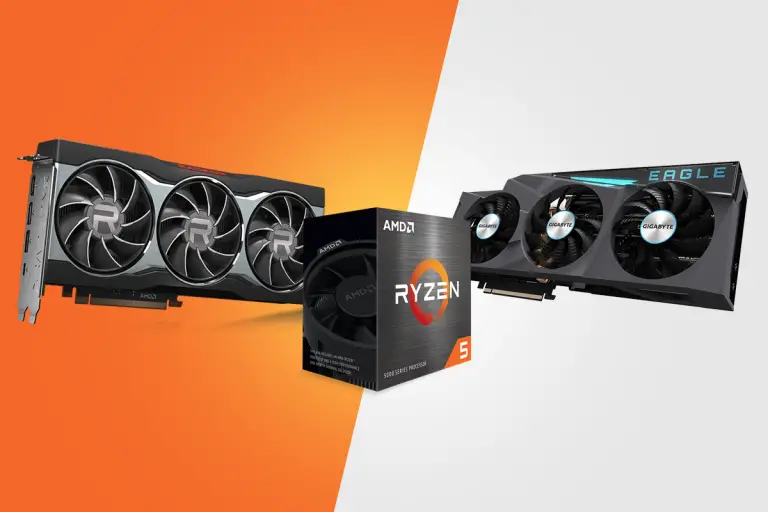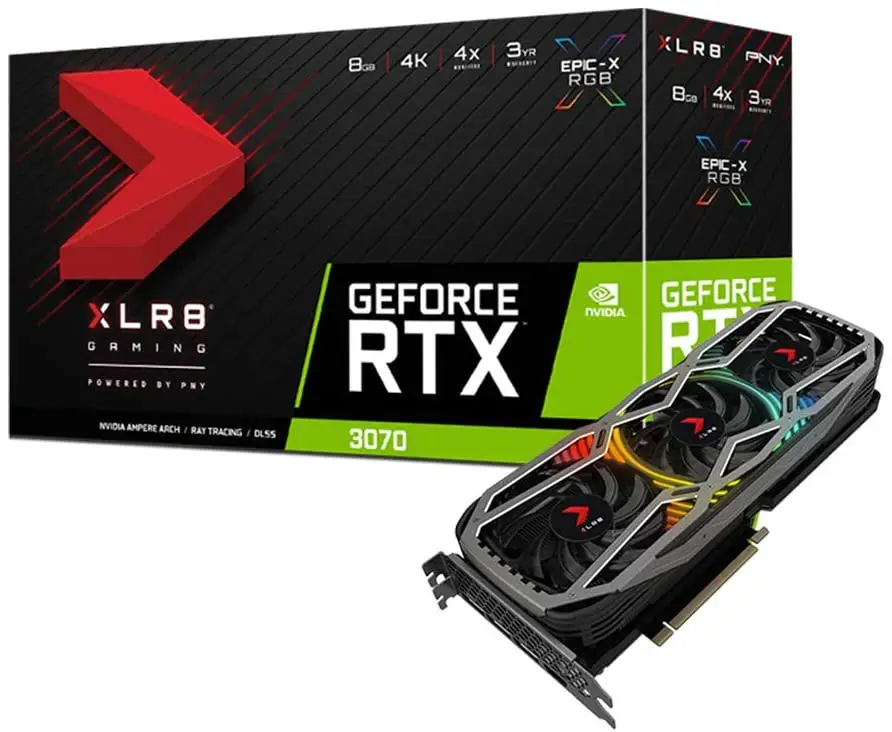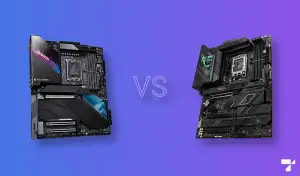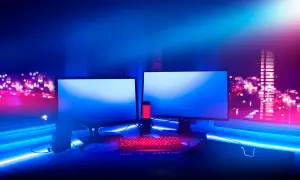AMD has been continuously improving its Zen core architecture, offering gamers more and more processing power for a variety of budgets. And with the announcement of the new ZEN 3 processors, everyone’s on the lookout for the best GPUs for Ryzen 5 5600X.
While the Ryzen 5000 series also includes higher-end processors, the 5600X boasts an impressive maximum boost clock of 4.6GHz while demanding only 65W of power, so it’s definitely going to be a popular choice for many. According to some benchmarks, this affordable 6-core processor can even compete with the i9-9900K, so it’s only natural a lot of us are going to use it in a solid gaming setup. But we all know that’s just one piece of the puzzle. A good processor like the Ryzen 5 5600X demands an equally well-performing GPU. So, let’s explore the best GPUs that work the best when paired up with the 5600X.
1. SAPPHIRE RX 6800 16GB NITRO+
Stream Processors: 3,840 | Core Clock: 1.7 GHz (2.19 GHz boost) | Memory: 16 GB GDDR6 | Memory Clock: 16 Gbps | Power Connectors: 2x PCIe 8-pin | Outputs: HDMI 2.1, 3x DisplayPort 1.4aThe Sapphire Nitro+ RX 6800 is the company’s flagship GPU that improves AMD’s already excellent reference design by featuring a beefy cooler and unique aesthetic that will be sure to look good in your new gaming rig. The card also comes factory overclocked out of the box with a boost clock of 2,190 MHz, the highest you can get in a custom RX 6800.
The cooling system comes with various enhancements that help the card go beyond its stock limits and keep noise levels low for distraction-free gaming. The three fans feature a hybrid design that combines an axial fan’s quietness with a blower fan’s larger airflow, giving you the best of both worlds. The card features multiple heatsinks with unique wave-shaped fins and V-shaped cutouts to reduce noise and improve heat dissipation.
A separate heatsink for the VRM and memory modules complete with two additional heat pipes and an independent fin stack enhances stability and increases the overclocking headroom. The card features a triple BIOS system, which lets you switch between the performance and silent modes manually or via software.
Sapphire’s TriXX Boost functionality, one of the card’s most underrated features, allows you to achieve better gaming performance by setting the screen resolution to a custom value. RGB on the GPU is limited to the light-up logos and a strip along the upper edge. You can use the TriXX software for RGB control, overclocking and even software BIOS switching.
As for outputs, the card replaces the USB-C port from the reference model for a more standard DisplayPort and is excellent if you’re looking at a triple monitor setup. Overall, the Sapphire Nitro+ is one of the best RX 6800 cards you can get and is our top recommendation if you’re willing to pay the extra price premium.
2. Nvidia Geforce RTX 3070
Specifications:
Stream Processors: 5,888 | Base/Boost Clock: 1500 MHz/1730 MHz | Memory: 8 GB GDDR6 | Memory Clock: 14Gbps | Power Connectors: 1x PCIe 8-pin | Outputs: 1x HDMI 2.1, 3x DisplayPort 1.4aKey features:
- Nvidia DLSS (Deep Learning Super Sampling)
- Turing Shaders
- PCI Express 4.0 support
- VR Ready
- Nvidia Broadcast
The RTX 3070 is the new gateway to optimal 4K gaming. Essentially, we can compare it to Nvidia’s previous flagship, the RTX 2080 TI, except that it’s available at half the price. 4K gaming has never been more accessible and affordable, especially when pairing this GPU with the affordable Ryzen 5 5600X.
Powered by the Ampere architecture, the RTX 3070 offers a great deal of raw performance without demanding a monstrous PSU. And that’s all thanks to the generational improvement that allowed Nvidia to fit double the number of CUDA cores that the previous generation RTX 2070 had, thus boosting rasterization performance. Furthermore, we also see significant improvements to ray tracing and DLSS by doubling the ray-tracing cores’ throughput. All of this is packed on a smaller chip that requires 220W of power, 100W less than its bigger brother the RTX 3080. Therefore cooling the system and supplying enough power should be easily achievable without breaking the bank.
With that in mind, the RTX 3070 also comes with a set of software-driven features that can be useful in gaming as well as outside of it. One such example is Nvidia Broadcast, which allows us to instantly replace the background during a video call, or just blur it out. Combined with the RTX Voice software that blocks out the mic’s background noise, this GPU becomes very handy during streaming sessions or online conferences. But gamers get to benefit as well, particularly from the RTX IO technology that’s meant to work with Microsoft’s DirectStorage API, which will speed up data delivery. This feature is going to remove the possibility of the CPU bottlenecking the GPU by transmitting data from the SSD directly to the GPU.
Nvidia’s RTX 3070 is more than just a gaming graphics card, it’s a piece of revolutionary technology. It’s powerful, affordable, and most importantly future-proof, especially when used together with AMD’s Zen 3 lineup of CPUs.
3. AMD Radeon RX 5700 XT Graphics
Specifications:
Stream Processors: 2,560 | Base/Boost Clock: 1605 MHz/1905 MHz | Memory: 8 GB GDDR6 | Memory Clock: 14Gbps | Power Connectors: 1x PCIe 8-pin and 1x PCIe 6-pin | Outputs: 1x HDMI, 3x DisplayPort 1.4Key features:
- Radeon Image Sharpening – Intelligent sharpening technology
- Radeon Anti-Lag latency reducer
- PCI Express 4.0 support
- Energy efficient
- VR Ready
In a GPU world dominated by Nvidia, AMD makes a comeback with their RX 5700 XT. Developed to be a solid competitor against the RTX 2070, AMD succeeds in offering solid gaming performance backed by a series of great features.
Unlike other graphics cards, the RX 5700 was built from its foundation with gaming in mind. AMD used their 7nm manufacturing process to focus specifically on game performance instead of raw computing power. This means that compared to the previous generation, the RX 5700 XT GPU offers better gaming performance despite lower clock speeds and it requires less power thanks to its 7nm architecture. Furthermore, the performance is boosted by the addition of several software features that were newly introduced.
With the release of the RX 5700 AMD introduced the Radeon Image Sharpening feature to tackle Nvidia’s rendering technology, DLSS (deep learning super sampling). This feature is more than just a sharpening filter because it’s contrast-aware and therefore it intelligently prevents weird artifacts and problematic textures from being generated.
Another important feature is the Radeon Anti-Lag system. This is particularly aimed towards gamers that care more about having perfect performance than the quality of the graphics because its objective is to reduce latency. This is especially exciting for streamers because the Anti-Lag system orders the CPU to wait for the GPU to be ready to send more frames. This results in lacking a frame buffer that waits in line to be displayed, so the input lag is significantly reduced.
But intelligent features aren’t enough without the raw power. Fortunately, the RX 5700 is a beast in its category and a monster for 1440p gaming. With that being said, this isn’t the ideal graphics card for 4K gaming because it’s just not made for the level of workload, but it can handle it to some degree.
All in all AMD’s RX 5700 XT is a solid choice when paired up with the Ryzen 5600X, but not it’s not the optimal solution if you’re interested in a 4K build.
4. AMD Radeon RX 5600 XT Graphics
Specifications:
Stream Processors: 2,304 | Base/Boost Clock: 1130 MHz/1560 MHz | Memory: 6 GB GDDR6 | Memory Clock: 14Gbps | Power Connectors: 1x PCIe 8-pin | Outputs: 1x HDMI, 3x DisplayPort 1.4Key features:
- Radeon Image Sharpening – Intelligent sharpening technology
- Radeon Anti-Lag latency reducer
- Radeon Boost
- PCI Express 4.0 support
- Energy efficient
AMD became dominant in the 1080p gaming market partially thanks to the RX 5600 XT graphics card. Despite Nvidia offering ray tracing technology and deep learning super sampling with its RTX 2060, the RX 5600 dominates with raw power at a low price point. So for those who are on a tight budget and interested only in 1080p gaming, the RX 5600 is the ideal GPU, especially when combined with the Ryzen 5600X.
Like its sibling, the RX 5700, it’s based on the 7nm architecture, offering a lot of performance while demanding a small amount of power. While it only has 6GB of memory, it’s more than enough for 1080p gaming, and it can handle 1440p resolutions as well, though not always at the highest settings. The memory capacity is a long-term downside, however, but we can’t fault AMD for it at such a low price point.
Fortunately, the RX 5600 also benefits from several software improvements. The most notable one is Radeon Boost, and it’s the main reason why the lack of ray tracing isn’t so badly felt. This feature boosts the frame rate, which is especially important in competitive games, by reducing the resolution of background scenery when the player’s camera moves too fast. This way we can play at higher frame rates without noticing any decline in the quality of the graphics. Together with the Radeon Ati-Lag feature, this budget-friendly GPU becomes the ideal choice for competitive gamers.
If you’re looking for the best 1080p experience, the Radeon RX 5600 XT might be the ideal choice together with the Ryzen 5600X. It’s affordable and it offers all the raw power you need for 1080p gaming.
5. Nvidia Geforce RTX 2070 Super
Specifications:
Stream Processors: 2,560 | Base/Boost Clock: 1605 MHz/1770 MHz | Memory: 8 GB GDDR6 | Memory Clock: 14Gbps | Power Connectors: 1x PCIe 8-pin and 1x PCIe 6-pin | Outputs: 1x HDMI 2.0b, 3x DisplayPort 1.4aKey features:
- Nvidia DLSS (Deep Learning Super Sampling)
- Ray Tracing
- Nvidia Adaptive Shading
- Nvidia SLI-Ready
- VR Ready
The RTX 2070 Super combines the affordability of the initial 2070 release and the unlocked power of the Super edition, which brings it close to the level of an RTX 2080. Despite Nvidia’s launch of the RTX 3000s series, this GPU remains a solid choice for the average gamer that just wants a solid experience with all the bells and whistles attached.
Thanks to a higher CUDA core count and higher clock speeds than its younger 2070 self, the RTX 2070 Super is an ideal choice for 1440p gaming and it can handle 4K gaming as well, at least at the medium to high settings. With more performance per dollar, this GPU is a reasonably priced way of gaining access to Nvidia’s sweet ray tracing technology.
The only reasonable downside is that while the RTX 2070 Super comes with a mid-range price tag, so does the new generation RTX 3070. They both cost around the same, but the 3070 packs a bigger punch, especially when it comes to 4K performance. While the 2070 GPU is still a good choice, fully compatible with the Ryzen 5600X processor, you might want to hold out until the price drops or get the 3070 instead.
6. Nvidia Geforce RTX 2060 Super
Specifications:
Stream Processors: 2,176 | Base/Boost Clock: 1470 MHz/1695 MHz | Memory: 8 GB GDDR6 | Memory Clock: 14Gbps | Power Connectors: 1x PCIe 8-pin | Outputs: 1x HDMI 2.0b, 3x DisplayPort 1.4aKey features:
- Nvidia DLSS (Deep Learning Super Sampling)
- Ray Tracing
- Nvidia Adaptive Shading
- VR Ready
Until recently, the RTX 2060 Super was a perfectly valid choice, especially for gamers on a tight budget. It performs almost as well as the RTX 2070 and it should allow us to play all games on 1440p at 60fps. However, with the launch of the RTX 3000s series and the fact that its price is not competitive when compared to the RTX 3060, the 2060 Super might not offer the biggest bang for the buck. However, due to its performance combined with almost all the latest features offered by Nvidia, this GPU could become a great choice once the price goes down.
With that being said, the RTX 2060 Super performs really well up to 1440p and it comes with that ray tracing package we all want for our games. The only real difference between this graphics card and the 2070 Super lies in numbers. It has fewer CUDA core and smaller clock speeds, and that’s pretty much it. So if you have an old system running with the GTX 1080 or GTX 970, the 2060 Super is well worth the purchase and combined with the Ryzen 5 5600X it will unlock a whole new world of gaming.
Final Thoughts
The rivalry between AMD and Nvidia has led to the development of several powerful yet affordable graphics cards. And that’s good news for every gamer out there, especially now with the release of AMD’s Zen 3 processor series and the new Radeon 6000 series of graphics cards. There’s never been a better time to build a high-end setup than now. So grab a Ryzen 5 5600X and pair it with a versatile RX 5700, a powerful RTX 3070, RX 6800, or any other option from this list. They’re all solid choices that will run in perfect unison with the 5600X. Moreover, you can check this bottleneck calculator to better determine which of the GPUs above is best for your Ryzen 5 5600x.




